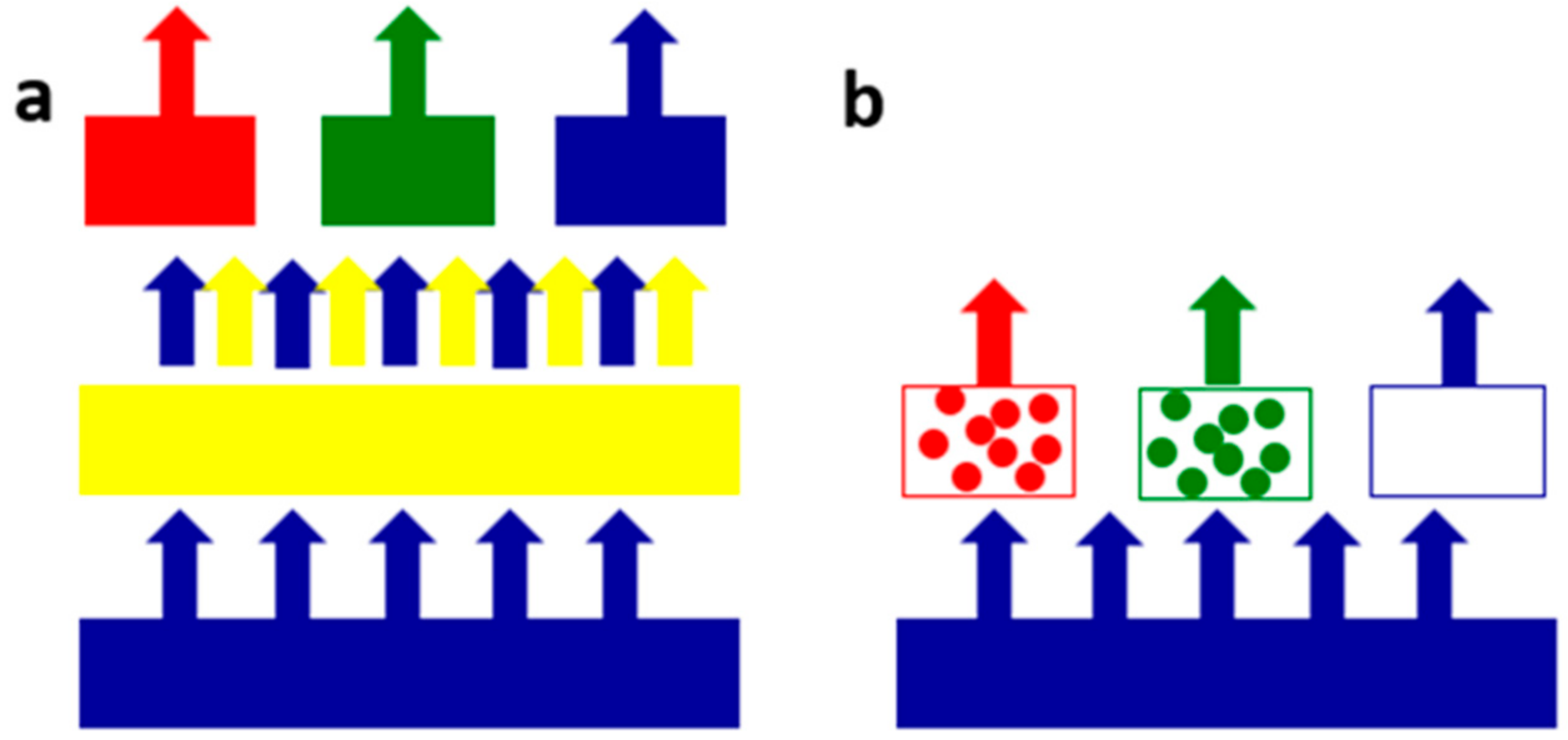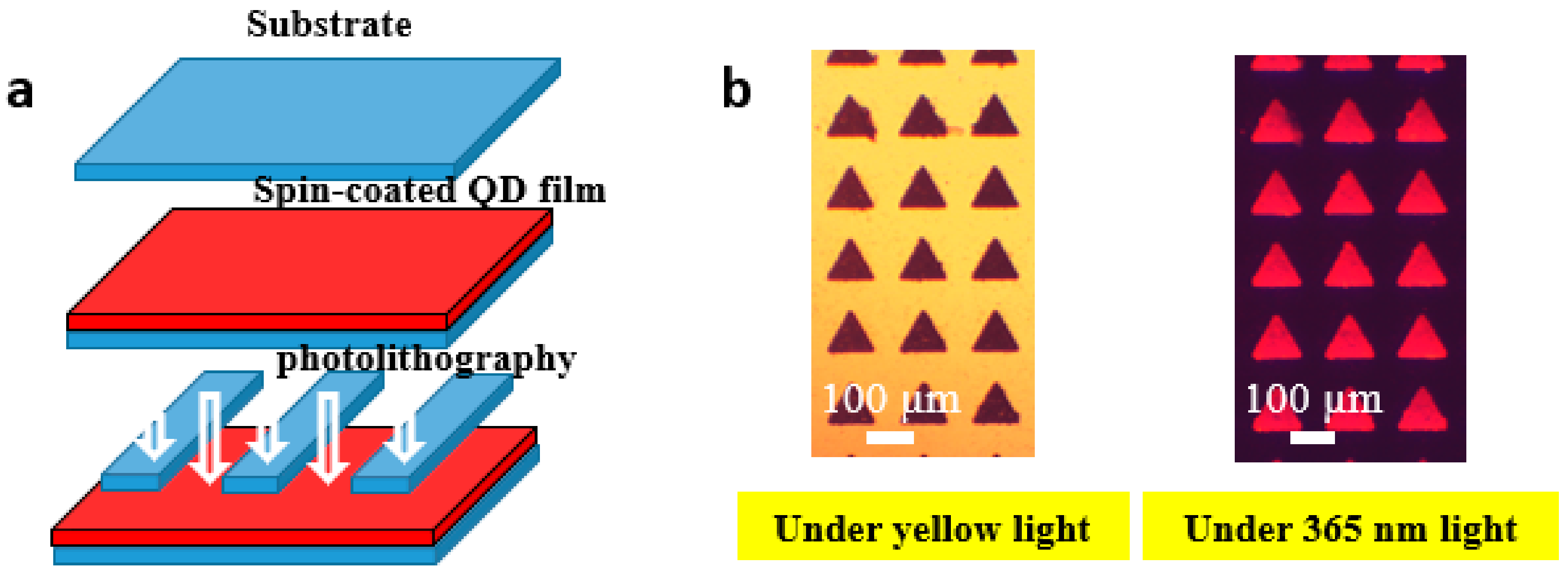Red and Green Quantum Dot Color Filter for Full-Color Micro-LED Arrays
Abstract
:1. Introduction
2. Experiments
2.1. Preparation
2.2. Characterization
3. Results and Discussion
4. Conclusions
Supplementary Materials
Author Contributions
Funding
Acknowledgments
Conflicts of Interest
References
- Wu, T.; Sher, C.-W.; Lin, Y.; Lee, C.-F.; Liang, S.; Lu, Y.; Chen, S.-W.H.; Guo, W.; Kuo, H.-C.; Chen, Z. Mini-LED and Micro-LED: Promising Candidates for the Next Generation Display Technology. Appl. Sci. 2018, 8, 1557. [Google Scholar] [CrossRef] [Green Version]
- Liu, Z.; Lin, C.-H.; Hyun, B.-R.; Sher, C.-W.; Lv, Z.; Luo, B.; Jiang, F.; Wu, T.; Ho, C.-H.; Kuo, H.-C.; et al. Micro-light-emitting diodes with quantum dots in display technology. Light Sci. Appl. 2020, 9, 83. [Google Scholar] [CrossRef] [PubMed]
- Hsiang, E.-L.; Li, Y.; He, Z.; Zhan, T.; Zhang, C.; Lan, Y.-F.; Dong, Y.; Wu, S.-T. Enhancing the efficiency of color conversion micro-LED display with a patterned cholesteric liquid crystal polymer film. Nanomaterials 2020, 10, 2430. [Google Scholar] [CrossRef] [PubMed]
- Zhao, B.; Zhang, X.; Bai, X.; Yang, H.; Li, S.; Hao, J.; Liu, H.; Lu, R.; Xu, B.; Wang, L.; et al. Surface modification toward luminescent and stable silica-coated quantum dots color filter. Sci. China Mater. 2019, 62, 1463–1469. [Google Scholar] [CrossRef] [Green Version]
- Bai, X.; Yang, H.; Zhao, B.; Zhang, X.; Li, X.; Xu, B.; Wei, F.; Liu, Z.; Wang, K.; Sun, X.W. 4-4: Flexible Quantum Dot Color Converter Film for Micro-LED Applications. SID Symp. Dig. Tech. Pap. 2019, 50, 30–33. [Google Scholar] [CrossRef]
- Xiaotong, F.; Tingzhu, W.; Bin, L.; Rong, Z.; Hao-Chung, K.; Zhong, C. Recent developments of quantum dot based micro-LED based on non-radiative energy transfer mechanism. Opto-Electron. Adv. 2021, 4, 210022. [Google Scholar]
- Lin, C.-H.; Lee, C.-F.; Lin, C.C.; Chu, C.-H.; Sher, C.W.; Liu, Z.; Kuo, H.C. Recent advances in organic light-emitting diodes: Toward smart lighting and displays, SID Symp. Dig. Tech. Pap. 2018, 49, 267–270. [Google Scholar] [CrossRef]
- Haverinen, H.M.; Myllylä, R.A.; Jabbour, G.E. Inkjet printing of light emitting quantum dots. Appl. Phys. Lett. 2009, 94, 073108. [Google Scholar] [CrossRef]
- Jiang, C.; Zhong, Z.; Liu, B.; He, Z.; Zou, J.; Wang, L.; Wang, J.; Peng, J.; Cao, Y. Coffee-ring-free quantum dot thin film using inkjet printing from a mixed-solvent system on modified ZnO transport layer for light-emitting devices. ACS Appl. Mater. Interfaces 2016, 8, 26162–26168. [Google Scholar] [CrossRef]
- Gao, A.; Yan, J.; Wang, Z.; Liu, P.; Wu, D.; Tang, X.; Fang, F.; Ding, S.; Li, X.; Sun, J.; et al. Printable CsPbBr 3 perovskite quantum dot ink for coffee ring-free fluorescent microarrays using inkjet printing. Nanoscale 2020, 12, 2569–2577. [Google Scholar] [CrossRef]
- Ko, J.; Chang, J.H.; Jeong, B.G.; Kim, H.J.; Joung, J.F.; Park, S.; Choi, D.H.; Bae, W.K.; Bang, J. Direct photolithographic patterning of colloidal quantum dots enabled by UV-crosslinkable and hole-transporting polymer ligands. ACS Appl. Mater. Interfaces 2020, 12, 42153–42160. [Google Scholar] [CrossRef] [PubMed]
- Ko, J.; Jeong, B.G.; Chang, J.H.; Joung, J.F.; Yoon, S.-Y.; Lee, D.C.; Park, S.; Huh, J.; Yang, H.; Bae, W.K.; et al. Chemically resistant and thermally stable quantum dots prepared by shell encapsulation with cross-linkable block copolymer ligands. NPG Asia Mater. 2020, 12, 19. [Google Scholar] [CrossRef]
- Riegler, J.; Ditengou, F.; Palme, K.; Nann, T. Blue shift of CdSe/ZnS nanocrystal-labels upon DNA-hybridization. J. Nanobiotechnol. 2008, 6, 7. [Google Scholar] [CrossRef] [PubMed] [Green Version]
- Hyun, B.R.; Sher, C.W.; Chang, Y.W.; Lin, Y.; Liu, Z.; Kuo, H.C. Dual role of quantum dots as color conversion layer and suppression of input light for full-color micro-LED displays. J. Phys. Chem. Lett. 2021, 12, 6946–6954. [Google Scholar] [CrossRef]
- Tohgha, U.; Deol, K.K.; Porter, A.G.; Bartko, S.G.; Choi, J.K.; Leonard, B.M.; Varga, K.; Kubelka, J.; Muller, G.; Balaz, M. Ligand induced circular dichroism and circularly polarized luminescence in CdSe quantum dots. ACS Nano 2013, 7, 11094–11102. [Google Scholar] [CrossRef]
- Zhang, J.X.J.; Hoshino, K. Optical transducers: Optical molecular sensing and spectroscopy. In Molecular Sensors and Nanodevices, 2nd ed.; Academic Press: Cambridge, MA, USA, 2019; Volume 5, pp. 231–309. [Google Scholar]
- Li, J.; Tang, Y.; Li, Z.; Liang, G.; Ding, X.; Yu, B. High thermal performance and reliability of quantum-dot-based light-emitting diodes with watt-level injection power. IEEE Trans. Device Mater. Reliab. 2019, 19, 120–125. [Google Scholar] [CrossRef]
- Meinardi, F.; McDaniel, H.; Carulli, F.; Colombo, A.; Velizhanin, K.A.; Makarov, N.S.; Simonutti, R.; Klimov, V.I.; Brovelli, S. Highly Efficient Large-Area Colourless Luminescent Solar Concentrators Using Heavy-Metal-Free Colloidal Quantum Dots. Nat. Nanotechnol. 2015, 10, 878–885. [Google Scholar] [CrossRef] [PubMed]
- Li, J.-S.; Tang, Y.; Li, Z.-T.; Kang, W.-Q.; Ding, X.-R.; Yu, B.-H. Study on reabsorption properties of quantum dot color convertors for light-emitting diode packaging. J. Electron. Packag. 2019, 141, 041006. [Google Scholar] [CrossRef]
- Keum, H.; Jiang, Y.; Park, J.K.; Flanagan, J.C.; Shim, M.; Kim, S. Photoresist contact patterning of quantum dot films. ACS Nano 2018, 12, 10024–10031. [Google Scholar] [CrossRef]
- Yang, J.; Hahm, D.; Kim, K.; Rhee, S.; Lee, M.; Kim, S.; Chang, J.H.; Park, H.W.; Lim, J.; Lee, M.; et al. High-resolution patterning of colloidal quantum dots via non-destructive, light-driven ligand crosslinking. Nat. Commun. 2020, 11, 2874. [Google Scholar] [CrossRef]





| Parameter | Epoxied Red QDs | Epoxied Red QDCF | Epoxied Green QDs | Epoxied Green QDCF | Pristine Green QD | Pristine Green QDCF |
|---|---|---|---|---|---|---|
| QY of Film (%) | 81.4 | 77.4 | 79.6 | 75.6 | 45.0 | 19.3 |
| FWHM (nm) | 32.5 | 33.8 | 25.0 | 25.8 | 25.0 | 26.6 |
| Peak Wavelength (nm) | 624.0 | 623.6 | 532.5 | 531.8 | 532.7 | 532.7 |
Publisher’s Note: MDPI stays neutral with regard to jurisdictional claims in published maps and institutional affiliations. |
© 2022 by the authors. Licensee MDPI, Basel, Switzerland. This article is an open access article distributed under the terms and conditions of the Creative Commons Attribution (CC BY) license (https://creativecommons.org/licenses/by/4.0/).
Share and Cite
Zhao, B.; Wang, Q.; Li, D.; Yang, H.; Bai, X.; Li, S.; Liu, P.; Sun, X. Red and Green Quantum Dot Color Filter for Full-Color Micro-LED Arrays. Micromachines 2022, 13, 595. https://doi.org/10.3390/mi13040595
Zhao B, Wang Q, Li D, Yang H, Bai X, Li S, Liu P, Sun X. Red and Green Quantum Dot Color Filter for Full-Color Micro-LED Arrays. Micromachines. 2022; 13(4):595. https://doi.org/10.3390/mi13040595
Chicago/Turabian StyleZhao, Bingxin, Qingqian Wang, Depeng Li, Hongcheng Yang, Xue Bai, Shang Li, Pai Liu, and Xiaowei Sun. 2022. "Red and Green Quantum Dot Color Filter for Full-Color Micro-LED Arrays" Micromachines 13, no. 4: 595. https://doi.org/10.3390/mi13040595
APA StyleZhao, B., Wang, Q., Li, D., Yang, H., Bai, X., Li, S., Liu, P., & Sun, X. (2022). Red and Green Quantum Dot Color Filter for Full-Color Micro-LED Arrays. Micromachines, 13(4), 595. https://doi.org/10.3390/mi13040595







